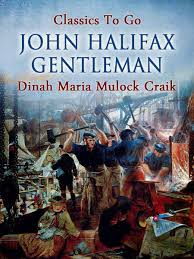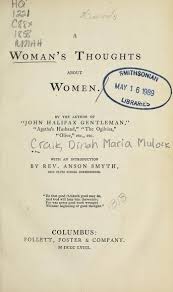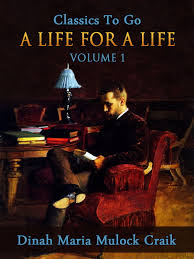
The Early Life of Dinah Maria Craik
Dinah Maria Mulock was born on 20th April 1826. She was born and raised in Stoke-on-Trent, Staffordshire in the West Midlands of England. Dinah was the first child of the nonconformist preacher, Thomas Samuel (father) and Dinah (Mellard) Mulock.
In 1829, Mulock was gifted with two brothers and their family was completed. Dinah’s childhood and teenage was affected by his father’s poor mental health and the debts he left for his family. Since an early age, Dinah was required to run a private school with her mother to suffice their daily need.
Despite having a tough childhood, she managed to get a good education and learn creativity of art and writing. Thomas lost his job in 1831 and the family then moved to Newcastle under Lyme to Mrs Mulock’s birthplace.
In the new city of Staffordshire, Mulock joined the Brampton House Academy. After Mrs Mulock inherited a huge fortune, which her father left for her, they travelled the whole of Europe and after inheriting some property, the family moved to London in 1839.
Dinah studied many different languages during the tour like French, Latin, and German and continued to learn the modern and classical language and developed her interest in music and art.
Start of her Literary Career
Her first publication was in 1841, a poem which appeared in in the Staffordshire Advertiser which was on the birth of the princess royal.
In 1844, the unpredictable father left his family in Staffordshire. A year later in 1845, Mulock’s mother died and she left a private school and her inherited fortune for her daughter and sons. When Dinah turned nineteen, she started writing poems and stories. Four years later, in 1849, she published her first adult fiction titled The Olivigies, which was dedicated to her mother.
Famous work of Dinah Maria Craik
After her first novel, she wrote some twenty novels which were a great success such as The Head of the Family in 1851, Agatha’s Husband in 1853, Alice Learmont in 1852 which is a fairy story, King Arthur: Not a Love Story was published in 1886 and published a numerous collection of short stories titled Avillion and other Tales in 1853. Another similar collection titled Nothing New was published in 1853.
Summary of her Famous Books
John Halifax, Gentleman

Dinah’s career reached another height with the publication of her novel John Halifax, Gentleman in 1856. The novel is centred in a town of Tewkesbury called Norton bury in Gloucestershire. The story is a narrative from a character Phineas, who is the friend of a leading character.
The central character John Halifax, who is an orphan, is keen to make his way through the competitive world with hard work and honesty. Abel Fletcher, a tanner, also a Quaker, gives him a job where he meets Abel’s son Phineas. With his true determination and hard work he earns a lot of money and becomes a wealthy man.
For a month, he goes on a vacation in the countryside near Enderley with Phineas and falls in love with a cottage mill owner’s daughter Ursula. Their marriage though never happened because of disapproval from the family. In the end, they both die quietly in the fullness of life and without any fear or pain within hours of each other.
The book shows that hard work and dedication can bring good. It is one of the rarest books which portrays a tradesman as a hero. The book is a lesson to virtue and prosperity and deals with practicality.
A Woman’s Thoughts about Women

A Woman’s Thoughts about Women is a collection of articles about what Dinah has learnt in her life. She wrote about the single women problems and the courage it takes to be an independent woman. Factors like friendship, gossip, worldliness, happiness and ageing are the need of the women. Her thought was to consider humans first and then differentiate a male and a female. This collection was initially published in Edinburgh Journal between 2 May and 19 December 1857 but later in 1858, Hurst and Blackett compiled it into a book.
A Life for a Life

It was Dinah’s favourite novel which was published in 1859. She wanted this novel to be about people who accept themselves and others without change and there is no societal influence on their views. The novel is about two diaries, one is of Max Urquhart and the other is of Dora Johnston.
Max had a guilty past which he is hiding and Dora who loves Max and even after family disapproval married him. The book deals with the issues of society and the pain everybody is facing due to some reason or the other. It illustrates an example of women who are suffering because she has a child without marriage and a man who is guilty of manslaughter.
Dinah describes that the two sufferings can be equally painful for each of them. The book has been criticized by a section of society who thinks when a certain crime is done people cannot go back to where they were but Dinah states that even a most sinful act can be redeemed if the sinners have remorse and paid the full price.
After realizing their mistakes Max Urquhart confesses his crime and Dora accepts her child. But the question remains whether they can be restored in the society. The book was Mulock’s greatest victory to her and she considers it one of her best works equally to John Halifax.
Famous Poems of Dinah Maria Craik
She published a great set of poems like A Marriage-Table, Only a Woman, A Lancashire Doxology, Green Things Growing, A Child’s Smile, A Sketch, A Dream Of Death, A True Hero, A Rejected Lover, North Wind and many others.
Famous Tales and Sketches
“The Poets of the People. II. Robert Burns” published on 19 September 1846, “Elspeth Sutherland (A Tale)” published in June 1847, “A Garden Party”,1867, “An Island of the Blest”, published in The Sunday Magazine in 1880, “How She Told a Lie” in 1881, and “A Meditation for the Times” published in February 1855.
Dinah Maria Craik Famous Novels
Christian’s Mistake (1862), Young Mrs Jardine (1879), The Woman’s Kingdom (1868, published in three volumes in 1869) and Mistress and Maid (1862) were serialized in Good Words, Hannah was serialized in Saint Paul’s from February till December, A Brave Lady was serialized in Macmillan’s Magazine from May 1869 till April 1870, Two Marriages in 1867, and A Noble Life published in 1866.
A life for a life was followed by Mistress and Maid published in 1863 and Christian’s Mistake (1865), a tale titled The Little Lame Prince (1874), Unkind Word and Other Stories, a city at play, his little mother and others.
Marriage
In 1865 she married George Lillie Craik and became Dinah Maria Mulock Craik. After marriage, she didn’t leave her writing and continued to write stories and novels. Another collection was titled The Unkind Word and Other Stories. Later Craik started writing more of creative and fancier tales which proved to be a huge success like The Little Lame Prince (1874), 1881 collection of poems titled Poems of Thirty Years, New and Old. In 1869, George and Mulock adopted George’s niece Dorothy.
Later Life and Demise of Dinah Maria Craik

Dinah lived with her husband at Shortlands, near Bromley, Kent for the rest of her life. She died while preparing for her daughter’s wedding on 12 October 1887 due to a heart attack. Her last words have been quoted as “Oh if I could live four weeks longer! But no matter, no matter!” Macmillan published her last work in the year 1887 which was titled An Unknown Country.
Contribution to the Literature by Dinah Maria Craik
Dinah Maria Mulock Craik was respected for her very acceptable, benevolent, nonjudgmental, generous nature. She has written not only about women’s perspective but also about humanity. She believed in the idea of humans rather than differentiating them with gender and society.
Her moralistic approach towards life and her kindness towards children can be seen in her poetry and tales. She believed that the truth of life is not living with wealth but with loved ones and family which she has shown in her famous work of John Halifax, Gentleman. She is still and will always be remembered as one of the sensible yet sensitive poets, author, and writer of her times.
She once wrote, “Oh my son’s my son till he gets him a wife, but my daughter’s my daughter all her life.”